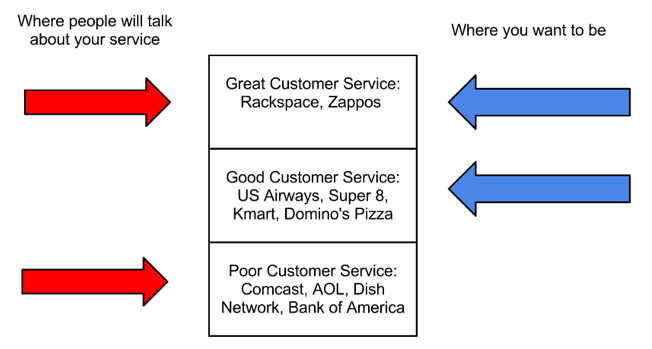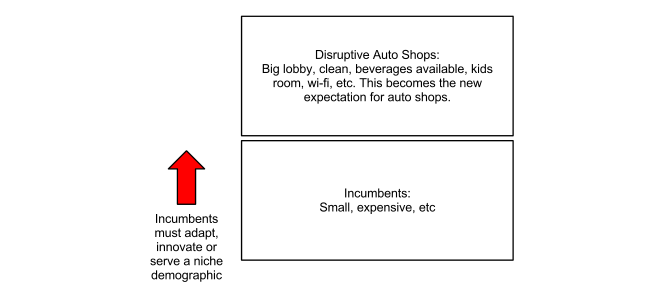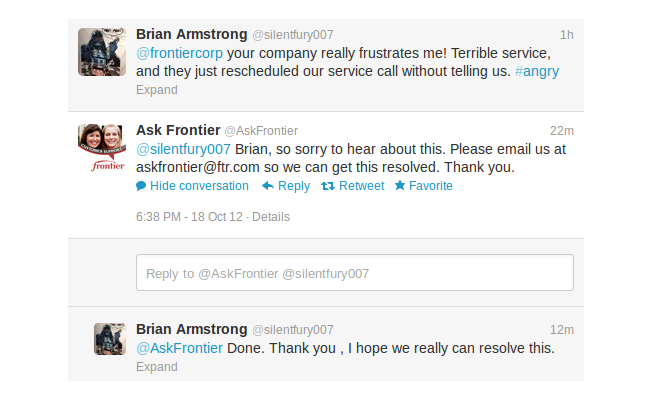Customer service is about expectations. And the expectations that customers have today were shaped by their previous experiences. Businesses need to meet or exceed these customer expectations.
Service is praised or criticized because of expectations.
After all, when do you hear people bring up customer service? Unless they are asked about it specifically, then they talk about it only when the service exceeds expectations or does not meet expectations. If service meets expectations, it’s doing what’s expected and won’t receive any praise or criticism.
To put it concisely, today’s blog post will boil down to one central idea:
Great customer service and poor customer service are the two extremes that get talked about. Good customer service doesn’t.
You may be thinking:
“When I go to a business, I certainly don’t have any particular expectations. I treat each business as a unique experience that’s separate from anything else.”
It generally doesn’t enter most people’s stream of consciousness.
But the fact is that when people use a service, they subconsciously go in with certain expectations. These expectations can also vary from industry to industry. For example, when people order food in a restaurant, they typically expect it to be on their table in about 10-15 minutes. Anything beyond that, and the restaurant will begin receiving complaints. Anything before that, and it’s typically a pleasant surprise. This doesn’t mean that people get out a stopwatch as soon as they order food, but their mental clock goes off if food hasn’t arrived on time.
In the automobile service industry, good service is generally not expected. A shop is expected to be an untrustworthy, expensive, dirty, noisy, male-dominated facility. So any service that’s good will have a competitive advantage. Many shops have already attempted to make their places more family and female friendly. Coffee, Wi-Fi, and kids toys are now available. The businesses are raising the expectation bar, and other shops likely will have to adapt or see their demise.
Other industries make great customer service available at a cost. This has led people to assume that the only way to get great customer service is to pay a premium.
Take the web hosting industry as an example, examining Rackspace and Amazon Web Services (AWS). One of Rackspace’s core competencies is its support, which is code named Fanatical Support. This support is one of the things that makes Rackspace such a successful company. (On the flip side, Rackspace is more expensive than AWS. So more companies and startups, in the cost-intensive environment they operate in, choose to go with AWS. Why? Because AWS has good support for the cost.)
Often, people willingly pay more for better customer service. Rackspace has thousands of customers. In their most recent 10-Q, Rackspace states:
We believe that our success depends on our ability to provide customers with quality service that not only meets our stated commitments, but meets and then exceeds customer service expectations. We refer to this high quality of customer service as Fanatical Support. If we are unable to provide customers with quality customer support in a variety of areas, we could face customer dissatisfaction, dilution of our brand, weakening of our main market differentiator, decreased overall demand for our services, and loss of revenue. In addition, our inability to meet customer service expectations may damage our reputation and could consequently limit our ability to retain existing customers and attract new customers, which would adversely affect our ability to generate revenue and negatively impact our operating results.
Zappos is another example of a business where customers are willing to pay more for premium service. It is one of the most successful e-commerce companies, and it certainly doesn’t compete on price. The experience and service that customers receive with Zappos make it successful and attract customers who are willing to pay more.
Other times, one company can change an entire industry. Let’s take a look at how Chipotle changed the service image for the fast food industry.
First, it’s difficult to place Chipotle in the same category as Taco Bell, McDonald’s, Burger King and other fast food outfits. It doesn’t meet the expectations of a typical fast food restaurant. It has a much smaller menu, uses higher quality meat, aims to be eco-friendly, and is a little more spendy than typical fast food restaurants. But yet, it still fits in the fast food category. It is ultimately changing the expectations for fast food and forcing others to change their menu.
Consumers’ expectations are changing all the time. As we’ve discussed, there are different expectations with each industry. Now let’s examine what consumers’ expectations mean for your company.
What it Means for Your Company
How is customer service viewed in your industry? How is the customer service of your competitors viewed by their customers? If everyone in your industry has great customer service, like the real estate industry, than just being “good” in your industry is “great” by other industry standards.
If your industry is known to have poor customer service, then average or excellent customer service can be a big competitive advantage.
At a startup business, everyone working there can and should own a piece of the customer service experience that is given to customers. For instance, everyone on the KISSmetrics team routinely talked to customers. Often, customers like hearing from someone besides a “customer service rep.” Some people like talking to the CEO, an engineer, or a marketing person. Each worker can give their own perspective.
To achieve this great customer service as a startup, everyone has to be in. No one should be exempt from communicating with customers and gathering feedback.
How does your company communicate with customers? Email and telephone? That might need to change.
Expectations are always evolving. People are using new ways to connect with companies. Social media is now a customer service channel. This doesn’t mean that your company needs to address customer problems via social media. Replying to tweets or putting in your bio will do the trick. Here’s an example from Virgin America:
Other companies will reply to tweets telling people to email them. Here’s an example from Frontier:
When companies do this, they are not reducing expectations. They reply to a tweet; and from there, it’s the company’s job to resolve the issue. The customer service “ticket” happens when a customer first sends out the tweet. The customer expects a reply back. If the company doesn’t respond, for whatever reason, the ticket is already off to a bad start.
The Expectation Game
It’s important to know where you stand in the Expectation Game. Most of the time, customers will let you know how you’re doing by giving you feedback. To garner feedback, a simple four question survey will do. It should be asked once the customer service “ticket” has closed:
- Was your issue resolved to your satisfaction?
- How was your customer service experience? A) Below expectations B) Met expectations C) Exceeded expectations
- Is there anything you would change about the service you received today?
- Is there anything else we can help you with?
Customers will also let you know via social media, email, or simply quitting your service. Your business should have a critical feedback loop in which outside criticism and praise are taken in and evaluated. Avoid an echo chamber in your business, and listen to what people are saying about you. It can help your business to know where you are and where you need to be.
Avoiding Poor Service
By avoiding poor customer service, you are thus providing either good or excellent service, which is what you want to do.
Here are some general tips to help you avoid poor customer service:
- Be available and answer emails/calls/tweets seven days a week. If a customer sends you an email the minute after you leave the office on Friday, are you really going to make the customer wait until Monday to get an answer?
- Make sure customers know how you can be reached. You can put this on your “Contact Us” page and your support page. Telephone number, email address, contact form, social media contacts, and live chat all work well.
- Use your customer’s name. It may seem like a small gesture, but using the person’s actual name can go a long way. Treat the customer like the fellow human being they are, not like “just another customer.”
- Make it really easy for customers to contact you. One way is to have a feedback box at the bottom of every page. See how KISSmetrics did this:
Customer service is a big part of business. It needs to be monitored and kept consistent. Control it before an incident gets spun out of control and destroys your company.
About the Author: Zach Bulygo is a blogger, you can follow him on Twitter @zachcb1.





Comments (29)